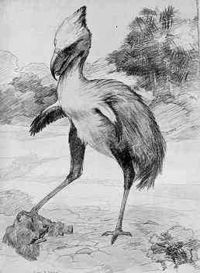Phorusrhacoids
Conservation status: Fossil
Fossil range:
Paleogene-Mid
Neogene |

Drawing of
Phorusrhacos longissimus, a
phorusrhacoid, by
Charles R. Knight
|
|
Scientific classification |
| Kingdom: |
Animalia
|
| Phylum: |
Chordata
|
| Class: |
Aves
|
| Order: |
Gruiformes
|
| Family: |
Phorusrhacidae
Ameghino, 1889 |
|
|
Synonyms |
Phororhacosidae
Ameghino, 1889
Phororhacidae
Lydekker, 1893
Brontornithidae
Moreno & Mercerat, 1891
Darwinornithidae
Moreno & Mercerat, 1891
Stereornithidae
Moreno & Mercerat, 1891
Patagornithidae
Mercerat, 1897
Devincenziidae
Kraglievich, 1932
Mesembriorniidae
Kraglievich, 1932
Phorusrhacidae
Brodkorb, 1963
|
Phorusrhacoids, or Terror Birds, were large
carnivorous flightless birds that were the dominant
predators in South America during the Cenozoic, 62–2.5
million years ago. They were roughly 1–3 meters (3–10 feet)
tall. Titanis walleri, one of the largest species, is known
from North America, marking one of the comparatively rare
examples where animals that evolved in South America managed
to spread north after the Isthmus of Panama landbridge
formed. The ancestors of T. walleri have not been found;
however, it is possible that more North American species
await discovery. Only a few bones of T. walleri have been
discovered at scattered locations in Florida and at a site
along the Texas coast. No complete skeleton exists of North
America's only known phorusrhacoid.
Phorusrhacoids are colloquially known as "terror birds",
because their larger species were top-level predators and
among the most fearsome carnivores of their habitat. Their wings had evolved to meathook-like structures that could be outstretched like
arms and were able to perform a hacking motion which
apparently was helpful in bringing down prey. Most of the
smaller and some of the larger species were fast runners.
Their closest modern-day relatives are the
seriemas, which do not, however, belong to the same
lineage.
A new (2006) specimen from Patagonia represents the
largest bird skull found yet; it has not been formally
described yet but might belong to a new taxon.
[1]
Taxonomy
Following the revision by Alvarenga and Höfling (2003),
there are now 5
subfamilies, containing 13
genera and 17
species:
- Subfamily Brontornithinae - gigantic species,
standing over 2 meters high
- Genus Brontornis
- Genus Physornis
- Genus Paraphysornis
-
Paraphysornis brasiliensis
- Subfamily Phorusrhacinae - gigantic species,
but somewhat smaller and decidedly more nimble than the
Brontornithinae
- Genus Phorusrhacos
- Genus Devincenzia
- Genus Titanis
- Subfamily Patagornithinae - medium-sized and
very nimble species, standing around 1.5 meters high
- Genus Patagornis
- Genus Andrewsornis
- Genus Andalgalornis
- Subfamily Psilopterinae - small species,
standing 70-100 centimeters high
- Genus
Psilopterus
- Psilopterus bachmanni
Psilopterus lemoinei
Psilopterus affinis
Psilopterus colzecus
- Genus Procariama
- Genus Paleopsilopterus
-
Paleopsilopterus itaboraiensis
- Subfamily Mesembriornithinae - medium-sized
species, standing between 1 and 1.5 meters high
- Genus
Mesembriornis
- Mesembriornis milneedwardsi
Mesembriornis incertus
Alvarenga and Höfling do not include the
Ameghinornithinae and Aenigmavis sapea from Europe in the phorusrhacoids;
they conclude that the former are close relatives, and the
latter is of uncertain affiliation.
References
- Alvarenga, Herculano M. F. & Höfling, Elizabeth
(2003): Systematic revision of the Phorusrhacidae
(Aves: Ralliformes). Papéis Avulsos de Zoologia
43(4): 55-91
PDF fulltext
- Ameghino, F. (1889): "Contribuición al conocimiento
de los mamíferos fósiles de la República Argentina",
Actas Academia Nacional Ciencias de Córdoba 6:
1-1028.
External links




